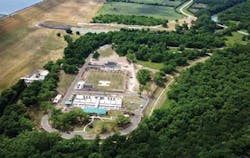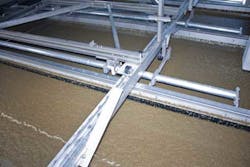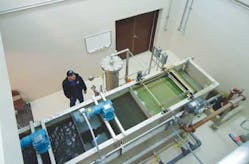Taste and odor (T&O) problems remain an issue across much of the nation where water plants draw from lakes and other surface sources. The phenomenon can be expensive to suppress with chemicals and, even then, is still hard to maintain.
During the hot and dusty summers a few years back in Waco, Texas, many residents were reluctant to slake their thirst with the city's water. However, that has changed since a dissolved air flotation (DAF) system entered service two years ago to purge the water utility's recurring T&O problem.
The water utility serving Waco has two plants and 67,492 connections along its 900 miles of mains. The city draws raw water from the 8,465-acre Lake Waco, whose watershed directly contributes nutrient loadings that further aggravate the strong T&O in the utility's finished water.
There was some early debate over whether the mission for the 90-foot-deep waterbody impoundment should be merely a replacement for a 39,000-acre-foot predecessor lake built in 1926 for drinking water or as a flood control structure. A convincing case could be made for both priorities since the region has endured both floods and severe drought. Many floods exceeded the retention of the old city lake, and drought could have sapped its pool until tall weeds emerged in the shallower areas. Accordingly, Lyndon B. Johnson exercised his political clout and made the project a federally-funded flood control facility that serves both missions, along with recreational uses.
Led by the U.S. Army Corps of Engineers, activity began on the multi-purpose project in 1958 to produce the 24,600-foot-long earthen dam across the Bosque River downstream from three tributaries. The dam rises 140 feet above the streambed with 14 gates at the spillway located in the left abutment. High water currently surging down the river is retained in the 553,300 acre-feet of storage capacity. The city of Waco exchanged the storage of its old lake for an equivalent amount from the new reservoir but has an underlying right to all of the conservation pool. The Brazos River Authority, a state agency, contracts with Waco for joint use of the remaining storage.
When the Corps closed the spillway gates in February 1965, the conservation pool initially filled to 59,000 acre-feet but was increased to 79,000 acre-feet by public referendum in 1998. The abundant supply of water has been the wellhead for the city's economic and population growth ever since and has proven reliable even during the strangling drought of 2011 to 2012, noted Curtis Smalley, program administrator for the city's water treatment operations.
T&O Problem Rooted in Algae Growth
The watersheds of the upstream tributaries of the Bosque River encompass the highest concentration of dairy farms in Texas. Under the right temperature conditions, the combined runoff carries in nutrients that supercharge the Mycrocystis, Anabaena and Oscillatoria algae. The residuals from the periodic blooms instill the T&O in the finished water reaching customer faucets. It was a sporadic situation for years and residents voiced unrelenting complaints about the objectionable character of the utility's water before the recent $55-million investment in plant upgrades, engineering, testing, inspection, and an access road. The combined Leopold® Clari-DAF® system and WEDECO® ozone disinfection system are credited with correcting the water quality and muting the complaints, said Smalley.
Taking the 'Bloom' off the Algae Problem
CH2M HILL and The Wallace Group teamed as consultants for the improvement program aimed not only at mitigating the T&O problem, but also at eliminating bottlenecks in the existing system, increasing capacity, improving disinfection and finding ways to improve performance of aging equipment. The Wallace Group was the lead firm and responsible for the civil requirements, while CH2M HILL developed the process design that explored several alternatives to remove the T&O. The Leopold Clari-DAF system emerged as the favored method.
The Clari-DAF system employs a radically different method than traditional methods of clarification. Until now, the clarification stage in water treatment was typically driven by the necessary type and quantity of flocculation chemicals required for a plant's raw water. The process then relied on the particulate matter settling to the bottom of the basin for filtration. The filtration efficiency can be compromised or overloaded by the contaminants or elevated turbidity in the raw water.
The Clari-DAF system, however, works differently, in that raw water particulates are flocculated with doses of alum, separated and then floated to the surface with micro-sized air bubbles generated by a saturator unit and dispersion headers located at the bottom of the contactor. The churning bubbles carry the floc upward to the surface, where it is skimmed off by a mechanical skimmer. The floc consists of suspended and colloidal solids, residual algae and other organics, along with oxidized solids and constituents (e.g., Fe and Mn). Now clarified, the raw water is removed through laterals at the bottom of the basin.
The Clari-DAF process has become widely accepted in Europe and other areas of the United States, but since Waco was a groundbreaking application in Texas, the state's regulators required pilot plant studies along with four rounds of bench scale tests to establish performance data. Leopold, owned by Xylem, Inc., offers sophisticated mobile facilities for this purpose.
Two separate Leopold Clari-DAF system pilot plants were utilized during the piloting phase of the project to prove performance. The pilot plants are 1/100th scale, state-of-the-art potable water treatment systems. The pilot units incorporate two static mixers acting as a rapid mix, two-stage flocculation for coagulation and dissolved air flotation followed by granular media filtration. The units have a fully-functional SCADA system that monitors and logs data from all onboard instruments which can be set for desired parameters.
The original pilot testing was conducted at flows of 36-81 gpm (8.2-18.4 m3/hr) or DAF loading rates of 4-9 gpm/sq. ft. (9.8-21.9 m/hr) based on total basin area. The final pilot test performed onsite was to prove the system at higher rates. Leopold's high-rate Clari-DAF pilot was tested operating with DAF loading rates of 9-12 gpm/sq. ft. (21.9-29.3 m3/hr) based on total basin area. In the pilot units, the adjustable flocculation tanks optimize the flocculation time and energy input, and the fully-adjustable recycle rate gives full process optimization. In order to determine the DAF effluent's effect on the filtration process, a percentage of the DAF effluent feeds two 1-square-foot gravity dual-media filters. The filters are fully automatic and operate in flow-controlled mode until reaching six feet of head loss when automatic backwashing ensues.
The technologies lived up to expectations, reached when the pilot plant operated on site in May/June and November/December of 2000. The first rounds at Lake Waco proved effective in reducing algae- induced T&O, color and total organic carbon (TOC) while delivering consistently low-turbidity effluent to maximize the duration of individual filter runs. The pilot tests achieved more than 2.5-log removal of algae cells, while producing clarified turbidities lower than 0.5 ntu; filtered water effluent ran less than 0.1 ntu. The sludge content produced during the pilot was 2 percent dry solids. The concentration demonstrated that a full-scale Clari-DAF installation would minimize dewatering and sludge disposal costs.
The utility engaged a third study in 2002 to confirm the data compiled during the first two and to assess any removal of Cryptosporidium and Giardia experienced in pilot tests elsewhere with similar raw water. The dairy farms in the watershed inherently elevate the risk of these pathogens. Under the direction of James Ezwald, PhD, the data compiled from variable protocols confirmed that a full-scale Clari-DAF plant would enhance removal of Giardia and Cryptosporidium. Log removals across the Clari-DAF system were between 3.7 and 4.12 for Cryptosporidium and between 3.58 and 4.31 for Giardia. Total log removals across the whole system, including the gravity filters process, were between 4.46 and 4.88.
Ozone Added as Primary Disinfection
A WEDECO ozone system was selected as the primary disinfection method for the upgraded plant. The powerful disinfection system actually complements the Clari-DAF system's primary role by oxidizing any remaining T&O contributing contaminants.
The system consists of three WEDECO PDO1000 generators sized for production of 1,000 ppd. In addition to the generators, the system has closed-loop cooling water equipment, a nitrogen boost system, sidestream injection equipment, and ozone destruct skids. The inclusion of the expandable ozone system in tandem with pathogen control of the Clari-DAF system should ultimately reduce the amount of chlorination ahead of the finished water's release into the distribution system, as required by state regulations.
"We've been optimizing both the DAF and ozone systems and are nearly complete with the paperwork for the final application stage of the ozone," Smalley said. "We expect the state regulators to issue credits for ozone early this year (2013)."
The studies not only proved that the systems exceeded regulatory quality standards, but the Clari-DAF system loading rates could be increased from the standard 6 gpm/sq. ft. to 12 gpm/sq. ft. This enabled the design to have eight cells versus 16 cells, which saved nearly $10 million in construction costs, according to Brian Fuerst, PE, senior project manager with the Dallas office of CH2M HILL.
The utility was so impressed with the use of the pilot plant that it also built a 1/100th scale pilot plant near the main DAF to use as a training facility for operating personnel, Smalley pointed out.
"The utility pilot tested two or three different methods but kept coming back to the dissolved air flotation system as the most effective," he added. "They were using a lot of carbon with the other methods, but carbon has been completely eliminated since the day the DAF plant came online. You could see a change in pretreatment quality using DAF within just 45 minutes to an hour compared to conventional chemical treatment."
Smalley added that "the raw water's turbidity level after a storm can be elevated from 10 to 70 ntu, and the DAF system can reduce that to a nominal 0.5 to 0.7 ntu."
On the cusp of taming objectionable T&O after a decade of sporadic episodes, the utility's consultants then had to design a facility compatible with the landscape overlooked by neighboring townhomes and condominiums. About 80 percent of the DAF installation was built underground in response to initial concerns about visual intrusions and process odor. Those concerns never materialized because of the below-grade installation and because the utility recycles the byproduct air into aeration units already in place at the lake intake.
The efforts to mitigate any visual impacts also preserved native landscaping and ground cover, along with trees and other growth during construction. The efforts proved so effective that the Texas Parks & Wildlife Department have designated the grounds as an official "Texas Wildscape."
CH2M HILL noted that soon after the DAF system went online, a local newspaper conducted blind 'taste tests' of the utility's finished water. Without exception, the water satisfied even skeptical participants as a total improvement. Some even asked for a second glass.






